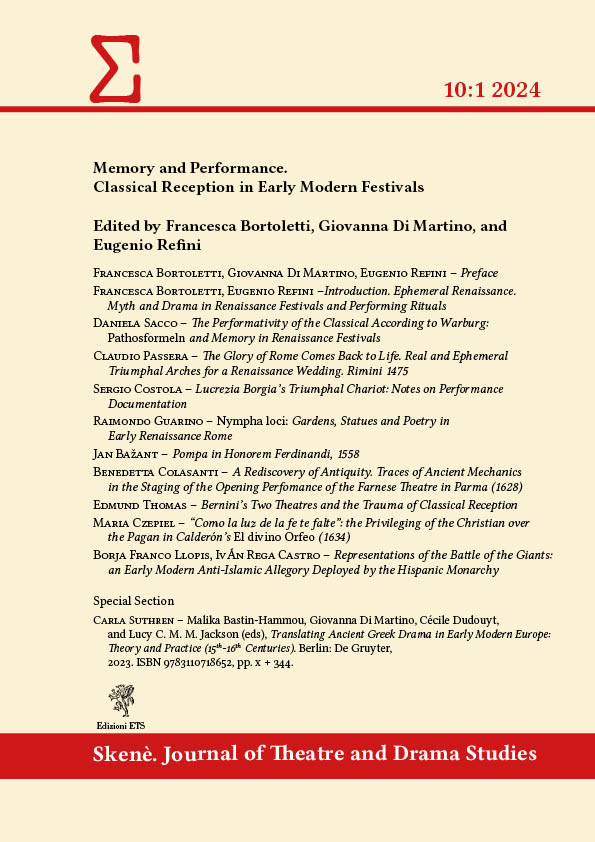Bernini’s Two Theatres and the Trauma of Classical Reception
DOI:
https://doi.org/10.13136/vw1ynf67Abstract
This article compares how the theatrical architectural spaces of Francesco Guitti at Parma and Gian Lorenzo Bernini at Rome used classical traditions of spectacle to satisfy contemporary sensationalist demands. Guitti’s stage machinery devised after ancient treatises recreated an ancient naumachia as a finale to the performance of the Mercury and Mars that celebrated the marriage of Odoardo, Duke of Parma, at the Farnese Theatre in Parma (see Benedetta Colasanti’s essay in this issue). Bernini’s spaces at the Rome Carnival in the 1630s played on other memories and misremembrances of popular classical spectacula to target elite audiences, generating a Bakhtinian mood of destabilising carnival laughter. He transformed naumachiae by flooding a stage to recreate a Tiber flood, and on the open-air setting of the ‘Festa d’Agone’, Domitian’s Stadium misremembered as a racetrack, he bestowed the authority of an ancient circus, with turning posts and obelisk. But his most destabilizing performance was to recast the disastrous mechanics of Gaius Curio’s legendary two revolving theatres in Republican Rome by means of a shocking pictorial perspective. This surpassed the technological schemes of other architect scenographers and exposed Rome’s gentry and curial classes to subversive spectacle.
Keywords: Gian Lorenzo Bernini; Francesco Guitti; stage painting; commedia dell’arte; architecture; carnival; Roman theatres
Downloads
Published
Issue
Section
License
Copyright (c) 2024 Skenè. Journal of Theatre and Drama Studies

This work is licensed under a Creative Commons Attribution 4.0 International License.
Open Access Policy
This journal provides immediate open access to its content on the principle that making research freely available to the public supports a greater global exchange of knowledge.
This Journal is a CC-BY 4.0 publication (https://creativecommons.org/licenses/by/4.0/). This Licence allows others to share the work with an acknowledgement of the work’s authorship and initial publication in this Journal, providing a link to the Licence and explicitly underlining any change (full mention of Issue number, year, pages and DOI is required).
- The Author retains (i) the rights to reproduce, to distribute, to publicly perform, and to publicly display the Article in any medium for any purpose; (ii) the right to prepare derivative works from the Article; and (iii) the right to authorise others to make any use of the Article so long as the Author receives credit as Author and the Journal in which the Article has been published are cited as the source of first publication of the Article. For example, the Author may make and distribute copies in the course of teaching and research and may post the Article on personal or institutional Web sites and in other open-access digital repositories.
- The Author is free to enter into separate, additional contractual arrangements for the non-exclusive distribution of the Journal’s published version of the work, with an acknowledgement of its initial publication in this Journal and explicitly underlining any change (full mention of Issue number, year, pages and DOI is required).
- The Author is permitted and encouraged to post their work online after the evaluation process has been successfully passed, as it can lead to productive exchanges as well as to a wider dissemination of the published work.

